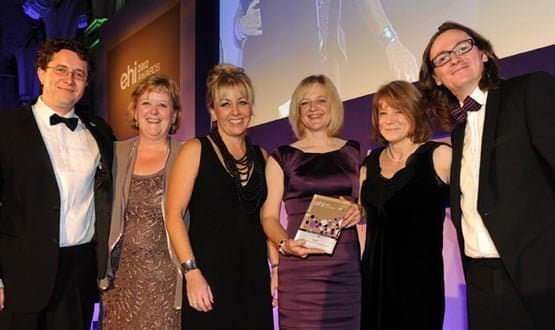Falling up
- 9 May 2013

A project that harnessed simple technology to deliver cost-effective, life-enhancing care to one of the least visible and least glamorous sections of the population was the winner of an EHI Award in 2012.
NHS Lothian won the category for ‘best use of telecare and telehealth’ for using technology to prevent falls in nursing homes.
The health board deployed falls detectors and bed and chair occupancy sensors to residents in nursing homes and then evaluated their effectiveness.
Roz Eccles, falls coordinator for the project, says the sensors cost approximately £300 each and resulted in an average 37% reduction in falls.
She compares this with the cost of treatment for a hip fracture of between £15,000 and £25,000, and points out that approximately 20% of emergency admissions to hospital with hip fractures come from nursing homes.
She adds: “This represents a significant cost reduction to the NHS. Quality of care is also improved as staff can often intervene more quickly and residents and staff have increased confidence in mobility as they know they will be found quickly if they have a fall.”
Looking to do better
The project was a joint initiative between NHS Lothian and East Lothian and Midlothian Councils. It started when the three organisations realised that existing methods for reducing falls were not delivering results.
Traditionally, falls reduction had focused on visiting care homes and conducting education sessions. But this had limited success because of the transient employment of care home staff and the difficulties of engaging them in a short session.
Eccles says: “We thought telehealthcare might work better as the care home staff would recognise the equipment as easing their workload.”
The possibility of workload savings was an attractive proposition for care homes that were looking after residents with rising care needs, including more patients with dementia and an increasing number of co-morbidities.
The project decided to target four homes, two of which were local-authority run and two of which were privately owned.
It set out to identify ten residents in each home who could benefit from the technology, using data from each care home’s falls register to identify those who had fallen most frequently.
Consent to take part in the project was sought from the individuals or those with power of attorney where applicable. Flyers were distributed to staff, residents and families before the project began.
Simple tech, works
The equipment, which the homes received on loan from the councils, included Tunstall’s CareAssist portable telecare alarm. This could be used by staff to receive alerts that told them what type of sensor had been activated and the name of the resident the sensor had been assigned to.
Residents were given falls detectors, which were worn on a belt around the waist, and bed and chair occupancy sensors, which could send an alert saying that a resident had left their bed or chair and not returned within a pre-set time period.
Eccles adds: “We didn’t want the staff to feel we were putting something else on to them so implementation was very important.”
The Lothian team helped the staff to put the equipment in and gave the project a high priority at the beginning to support staff using the equipment, sort out any problems and encourage homes to persevere.
It was recognised that staff, residents and their families needed to be confident that the equipment was reliable and that someone would be on hand to deal with technical difficulties. In addition, each home also had a telecare champion who other staff could go to if they were having problems.
Eccles says this approach paid dividends and the staff became increasingly confident in using the equipment and also saw the benefits of it.
At the end of the four month trial, data was compared on falls experienced by the 40 residents in the four months before the trail and during the project. This led to the average 37% reduction in falls across the sites.
Benefits lead to wider adoption
Eccles says that as well as reducing falls the equipment also led to improvements in residents’ mobility. People were more confident they would be found if they fell, and they were therefore more likely to move around. In addition, there were savings in staff time as they no longer had to do routine checks on residents.
Eccles adds: “This has proved particularly valuable overnight as residents are no longer disturbed by two hourly checks and staff are freed up for other tasks. Residents also value the increased privacy as there is less routine monitoring required.”
Eccles points out that after the initial investment in the equipment it is completely reusable and can be moved from patient to patient as required.
The pilot has since been extended to care homes across Midlothian and East Lothian. The equipment is also being used on continuing care wards at Midlothian Community Hospital, where it has also led to a substantial decrease in falls. For hospital use, the system needs to be compatible with nurse call systems.
Eccles says the care homes in particular value the advice about which pieces of equipment are useful and adds, for example, that the team has found floor sensors less useful than other items of equipment.
Her advice to other areas planning to target telecare in care homes and community hospitals is to work closely with the staff involved, be visible when the equipment is installed, follow up to make sure any problems are ironed out and the equipment is being used to its maximum potential, and to maintain an ongoing relationship.
Lothian’s achievements across all these areas is undoubtedly what helped it to beat off its competitors to become the telecare winner of 2012.
 If you have been involved in a great IT or information-enabled project, you have only a few days left to enter it into the EHI Awards 2013 in association with CGI. The closing date for entries this year is Friday, 10 May, at 4pm.
If you have been involved in a great IT or information-enabled project, you have only a few days left to enter it into the EHI Awards 2013 in association with CGI. The closing date for entries this year is Friday, 10 May, at 4pm.
This year’s black tie awards dinner will be held at the prestigious Roundhouse in north London on 10 October. For information about sponsorship opportunities contact head of events Neil Hadland. Tickets will also be on sale soon.




